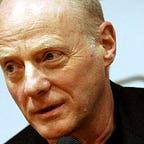An Introduction to Jonathan Carroll
by Neil Gaiman
All poets and story tellers alive today make a single brotherhood; they are engaged in a single work, picturing our human life. Whoever pictures life as he sees it, reassembles in his own way the details of existence which affect him deeply, and so creates a spiritual world of his own.”
-Nathaniel Long, Notes Toward a New Mythology.
There are millions of competent writers out there. There are hundreds of thousands of good writers in the world, and there are a handful of great writers. And this is me, late at night, trying to figure out the difference for myself. That indefinable you-either-got-it-or-you-ain’t spark that makes someone a great writer.
And then I realise that I’m asking myself the wrong question, because it’s not good writers or great writers. What I’m really wondering is what makes some writers special. Like when I was a kid on the London Underground, I’d stare at the people around me. And every now and again I’d notice someone who had been drawn — a William Morris beauty, a Berni Wrightson grotesque — or someone who had been written — there are lots of Dickens characters in London, even today. It wasn’t those writers or artists who accurately recorded life: the special ones were the ones who drew it or wrote it so personally that, in some sense it seemed as if they were creating life, or creating the world and bringing it back to you. And once you’d seen it through their eyes you could never un-see it, not ever again.
There are a few writers who are special. They make the world in their books; or rather, they open a window or a door or a magic casement, and they show you the world in which they live.
Ramsey Campbell, for example, writes short stories that, read in quantity, will re-form your world into a grey and ominous place in which strange shapes flicker at the corner of your eyes, and a patch of smoke or a blown plastic shopping bag takes on some kind of ghastly significance. Read enough R.A. Lafferty and you will find yourself living in a quirky tall-tale of a world in which the people have all stepped out of some cosmic joke, if it is not a dream.
Jonathan Carroll’s a changer. He’s one of the special ones, one of the few. He paints the world he sees. He opens a window you did not know was there and invites you to look through it. He gives you his eyes to see with, and he gives you the world all fresh and honest and new.
In a bookstore universe of bland and homogenised writers and fictions, the world that words from Carroll’s fountain pen is as cool, as fine and as magical as a new lover, or cool water in the desert. Things matter. You can fall in love with his women, or his men, worry when they hurt, hate them when they betray or fall short, rejoice when they steal a moment of magic and of life from the face of death and eventual nothingness.
I had dinner with Jonathan Carroll, with Dave McKean and with some friends, about eight years ago: what I still remember is not the meal nor even the conversation (although I do recall Jonathan telling us some incidents of his life that I would later encounter in Kissing the Beehive): what I recall was the process of becoming a Jonathan Carroll character among Jonathan Carroll characters. We were witty and wise and lucent; intelligent and beautiful men and women; artists and creators and magicians, we were.
It was a couple of days before I noticed that I had become a mundane grey person once more.
Writing fiction is not a profession that leaves one well-disposed toward reading fiction. One starts out loving books and stories, and then one becomes jaded and increasingly hard to please. I read less and less fiction these days, finding the buzz and the joy I used to get from fiction in ever stranger works of non-fiction, or poetry. But a new book by Jonathan Carroll is still, as they used to say on the back of the book jackets, a cause for celebration.
He has the magic.
His most successful books and tales defy genre categorisation. They’ve more life, more balls, are more true than pretty much anything else you’ll encounter out there. They call some fantasies ‘Magical Realism’ to try and lend them respectability, like a whore who wishes to be known as a lady of the evening. Jonathan Carroll’s work, however, has every right to parade under the banner of magical realism, if you have to call it something.
I call them Jonathan Carroll stories, and leave it at that. He is one of the handful, and one of the brotherhood. If you don’t believe me, pick up Outside the Dog Museum, or A Child Across the Sky, or Sleeping in Flame or The Panic Hand, or, any of his other works (you’ll find a list of them within, I have no doubt) and find out for yourself.
He’ll lend you his eyes; and you will never see the world in quite the same way ever again.
